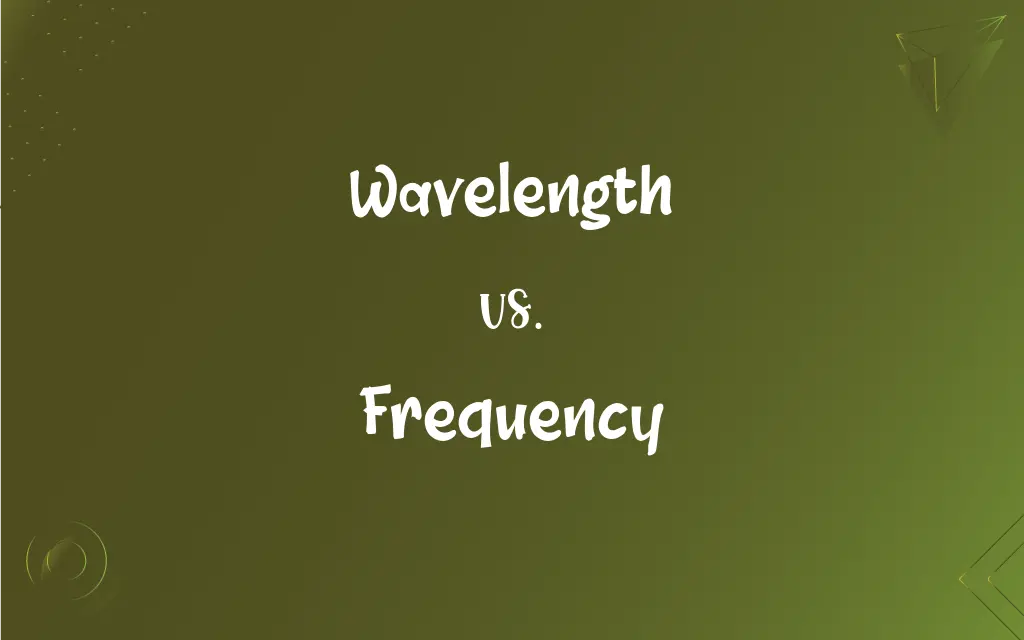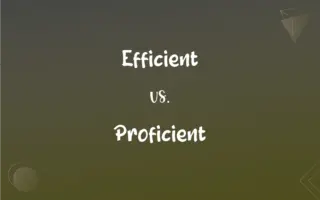Wavelength vs. Frequency: What's the Difference?
Edited by Harlon Moss || By Janet White || Published on October 24, 2023
Wavelength is the distance between successive points of a wave, while frequency is the number of waves that pass a fixed point per second.

Key Differences
Wavelength and frequency are integral concepts in wave mechanics, particularly in understanding electromagnetic waves. Wavelength represents the spatial period of the wave, essentially the distance between one point of a wave and the identical point on the next wave. It is typically measured in meters. Frequency, conversely, is a temporal measurement representing how many wave cycles occur in one second, measured in hertz (Hz).
The relationship between wavelength and frequency is inversely proportional in the context of the speed of light; as the frequency of a wave increases, the wavelength decreases and vice versa. This principle holds because the speed of light is a constant value, approximately
3.00
×
1
ADVERTISEMENT
8
3.00×10
meters per second. Therefore, higher frequency waves have shorter wavelengths, and lower frequency waves have longer wavelengths.
While wavelength gives a spatial perspective on waves, denoting the physical length of a wave cycle, frequency provides a dynamic view, reflecting how often a wave cycle occurs in a given timeframe. Wavelength is a crucial parameter for understanding the geometrical and physical attributes of waves, affecting aspects like diffraction and interference. In contrast, frequency is vital for exploring the wave’s temporal characteristics and its interaction with matter, impacting energy levels and resonances.
The interdependence of wavelength and frequency is crucial for the analysis and application of wave properties in various scientific fields. For instance, in optics, the wavelength determines the color of light perceived, with different wavelengths corresponding to different colors. Frequency, being related to energy, is pivotal in fields like acoustics and electronics, where it influences the pitch of sound and the tuning of circuits respectively.
ADVERTISEMENT
Analyzing both wavelength and frequency is fundamental in multiple scientific domains like physics, engineering, and music, each providing unique insights into the nature and properties of waves. The understanding of wavelength allows scientists to study the spatial configurations and interactions of waves, while the assessment of frequency enables the exploration of energy interactions and wave occurrences over time.
Comparison Chart
Definition
Distance between successive points of a wave.
Number of waves that pass a fixed point per second.
Measurement Unit
Meters (m)
Hertz (Hz)
Nature
Spatial
Temporal
Relation
Inversely proportional to frequency.
Inversely proportional to wavelength.
Importance
Crucial for understanding wave’s physical attributes.
Important for studying the wave’s temporal interactions.
Wavelength and Frequency Definitions
Wavelength
Wavelength represents the distance between equivalent points of adjacent waves.
In a vacuum, light travels at a constant speed, allowing the calculation of wavelength from frequency.
Frequency
Frequency is the rate at which a wave cycle occurs.
High-frequency sounds are perceived as high-pitched.
Wavelength
Wavelength is the spatial measurement of a wave cycle.
Red light has a longer wavelength than blue light.
Frequency
It is the number of wave cycles per second.
Radio waves have a lower frequency than microwaves.
Wavelength
It is a determinant of the wave’s physical and geometrical properties.
The wavelength of light determines its color.
Frequency
Frequency denotes the temporal occurrence of wave cycles.
Increasing the frequency of a wave decreases its wavelength.
Wavelength
It is the distance between corresponding points of two consecutive waves.
The wavelength of a sound wave can affect its pitch.
Frequency
It signifies the wave’s interaction with time and energy levels.
The frequency of a wave is inversely proportional to its wavelength.
Wavelength
Wavelength corresponds to the physical length of a wave.
The shorter the wavelength, the higher the energy of the wave.
Frequency
Frequency is a determinant of the energy level of a wave.
Gamma rays have a very high frequency and are thus highly energetic.
Wavelength
The distance between one peak of a wave to the next corresponding peak, or between any two adjacent corresponding points, defined as the speed of a wave divided by its frequency.
Frequency
The property or condition of occurring at frequent intervals.
Wavelength
(physics) The length of a single cycle of a wave, as measured by the distance between one peak or trough of a wave and the next; it is often designated in physics as λ, and corresponds to the velocity of the wave divided by its frequency.
Frequency
The number of repetitions of a complete sequence of values of a periodic function per unit variation of an independent variable.
Wavelength
(figurative) A person's attitude and way of thinking as compared to another person's.
I think you and I are on a different wavelength.
Frequency
The number of complete cycles of a periodic process occurring per unit time.
Wavelength
The distance (measured in the direction of propagation) between two points in the same phase in consecutive cycles of a wave
Frequency
The number of repetitions per unit time of a complete waveform, as of an electric current.
Wavelength
A shared orientation leading to mutual understanding;
They are on the same wavelength
Frequency
The number of measurements or observations having a certain value or characteristic.
Frequency
See relative frequency.
Frequency
The rate of occurrence of anything; the relationship between incidence and time period.
With growing confidence, the Viking’s raids increased in frequency.
Frequency
(uncountable) The property of occurring often rather than infrequently.
Frequency
(countable) The quotient of the number of times a periodic phenomenon occurs over the time in which it occurs: .
Frequency
(statistics) number of times an event occurred in an experiment (absolute frequency)
Frequency
The condition of returning frequently; occurrence often repeated; common occurence; as, the frequency of crimes; the frequency of miracles.
The reasons that moved her to remove were, because Rome was a place of riot and luxury, her soul being almost stifled with, the frequencies of ladies' visits.
Frequency
A crowd; a throng.
Frequency
The number of occurrences within a given time period (usually 1 second);
The frequency of modulation was 40 cycles per second
Frequency
The ratio of the number of observations in a statistical category to the total number of observations
Frequency
The number of observations in a given statistical category
FAQs
Why is wavelength important in physics?
Wavelength is important for understanding the spatial attributes, diffraction, interference, and color of waves in various applications and studies.
How are wavelength and frequency related?
They are inversely proportional; as the wavelength increases, the frequency decreases and vice versa, considering the speed of light is constant.
Is frequency directly related to energy?
Yes, higher frequency waves have higher energy levels, and lower frequency waves have lower energy levels.
Can wavelength be negative?
No, wavelength represents a physical distance and cannot be negative.
How does wavelength affect sound?
In sound, wavelength affects the pitch; longer wavelengths produce lower pitches, and shorter wavelengths produce higher pitches.
Can a wave have high frequency and long wavelength simultaneously?
No, due to their inverse relationship, a high frequency corresponds to a short wavelength, and a low frequency corresponds to a long wavelength.
Can humans perceive all wavelengths of light?
No, humans can only perceive a limited range of wavelengths as visible light; wavelengths outside this range are invisible to the human eye.
Can frequency be zero?
Theoretically, a frequency of zero would mean no wave is present as it represents wave cycles per second.
Is wavelength dependent on the medium?
Yes, the speed and wavelength of a wave can change based on the medium through which it travels, affecting its frequency.
How does frequency affect light?
In light, frequency affects color and energy; higher frequencies correspond to blue light and higher energy, while lower frequencies correspond to red light and lower energy.
Why is measuring frequency important?
Measuring frequency is crucial for understanding wave energy, tuning circuits in electronics, analyzing sound in acoustics, and numerous other applications.
What unit is used for measuring wavelength?
Wavelength is typically measured in meters (m), but can also be represented in nanometers (nm) or other units of length.
Can frequency change with medium?
While the speed of a wave and its wavelength can change with the medium, the frequency of a wave typically remains constant.
About Author
Written by
Janet WhiteJanet White has been an esteemed writer and blogger for Difference Wiki. Holding a Master's degree in Science and Medical Journalism from the prestigious Boston University, she has consistently demonstrated her expertise and passion for her field. When she's not immersed in her work, Janet relishes her time exercising, delving into a good book, and cherishing moments with friends and family.
Edited by
Harlon MossHarlon is a seasoned quality moderator and accomplished content writer for Difference Wiki. An alumnus of the prestigious University of California, he earned his degree in Computer Science. Leveraging his academic background, Harlon brings a meticulous and informed perspective to his work, ensuring content accuracy and excellence.





































































